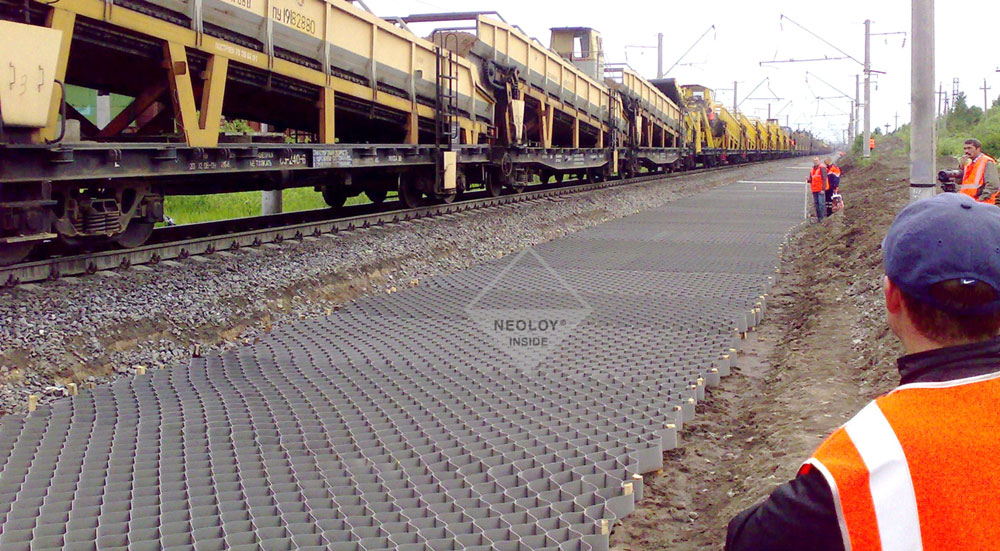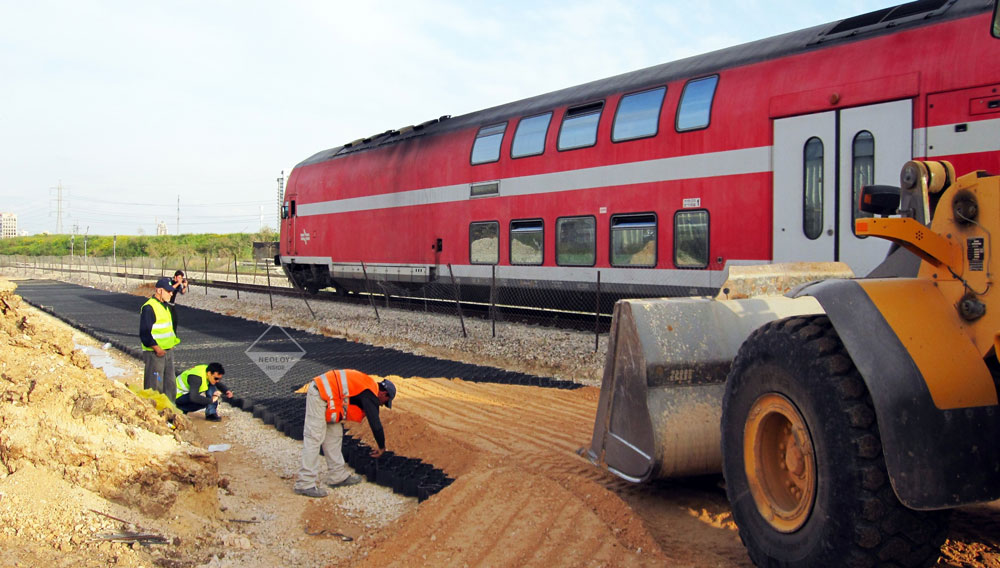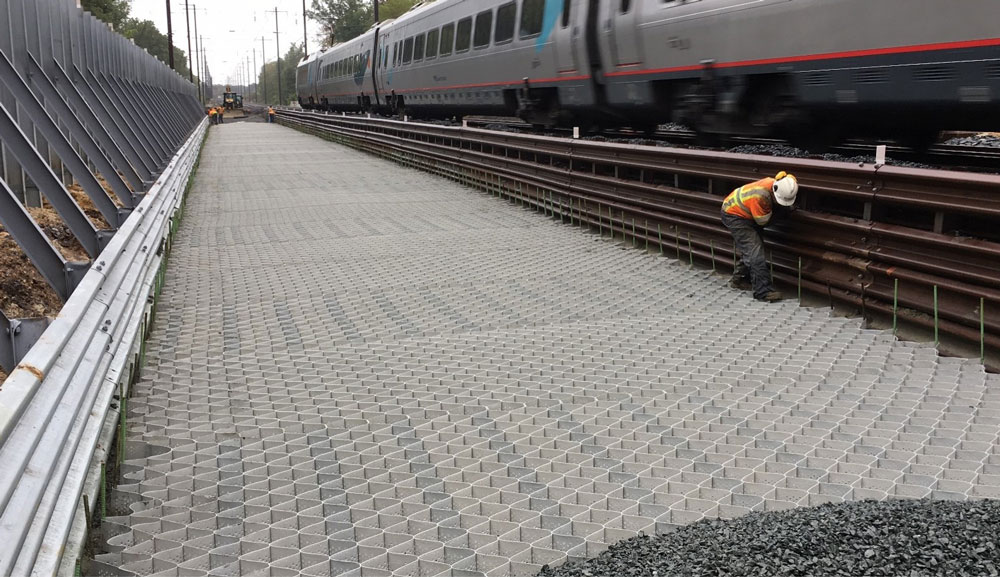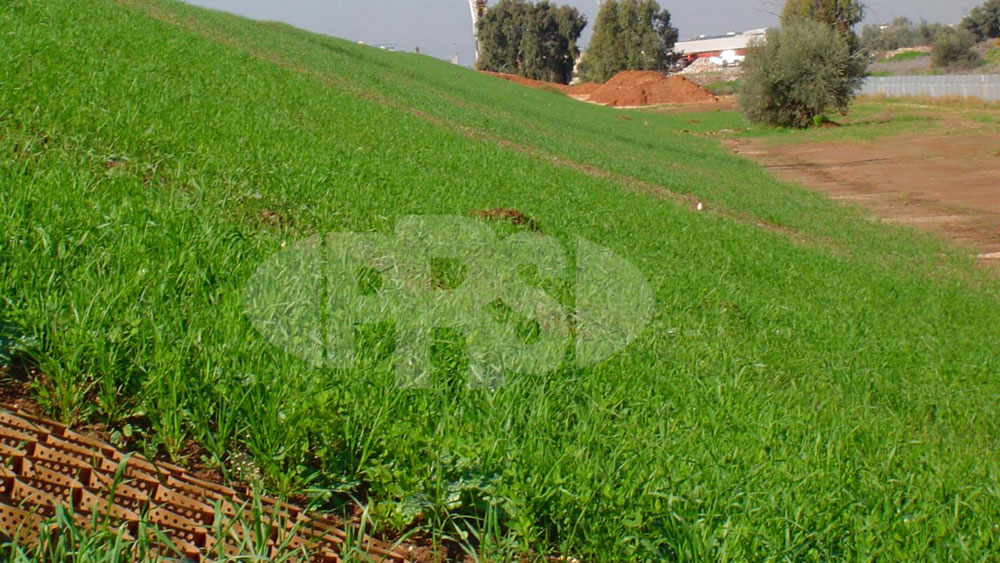Neoloy® geocells enhance the efficiency of railway tracks and rolling stock while significantly optimising the economic viability of new track construction and track rehabilitation projects.
Ensuring safe and seamless railway operations involves mitigating wear and tear on mainline track surfaces and ballast layers, especially crucial for high-speed passenger operations and transporting heavy freight. Strengthen the track substructure, stabilize ballast layers, subgrade, and embankments, effectively reducing track degradation and maintenance intervals. Prove significant improvements in problematic soils like sand or reactive soils. Neoloy brings base reinforcing options to a contractor, allowing the use of locally poor quality excavated materials that would previously not be considered in a conventional construction method.
Proven over thousands of projects across the Globe, Neoloy gives you the opportunity to cut, reduce and save on materials, time and ultimately cost of construction.
Trackbed stabilization
- Neoloy alters physical and mechanical properties.
Ballast life extended
- by reduced lateral displacement, vertical settlement and aggregate attrition.
Neoloy strength
- high stiffness, dimensional stability and low creep under loading preserve track geometry.
Reduce layer thickness
- reduce sub-ballast layer and use locally available soils for sub-ballast.
More effective than geogrids
- does not require high grade aggregate and has 3D zone of influence.
Rail
Subballast Reinforcement
Neoloy® Tough-Cells Reduce Degradation and Deformation, reinforcing the track substructure layer underneath the ballast layer. It reduces degradation of the embankments by creating a stiff mattress.
The long-term performance of the substructure under the ballast layer is critical as it is not subject to regular maintenance. Neoloy Tough-Cells reinforce the track substructure layer underneath the ballast layer. It reduces degradation of the rail embankments by creating a stiff mattress (semi-rigid platform), which behaves more like a three-dimensional semi-rigid slab or beam effect. The high shear strength and greater load distribution of Neoloy Tough-Cells reduce vertical stresses reaching the subgrade.
The increased bearing capacity of the subgrade strengthens the subballast layer and reduces settlement and accumulated degradation, thereby preventing deformation of the rail embankments. Neoloy reinforcement of the track substructure over problematic subgrade reduces surfacing cycles on the order of double or even more, and enables faster train speeds and heavier loads.
In addition lower quality infill can be utilized in place of expensive well-graded subballast aggregate, while the thickness of the subballast layer can be reduced by up to 50% with no reduction in structural strength.


Rail
Reinforcement of Railway Track Base
The Railway Construction Challenge
Railway track geometry and maintenance is very sensitive to the track substructure, subgrade and/or ballast conditions and train speeds and loads. In fact, the cost of maintaining such infrastructure over time (Total Cost of Ownership) determines the economic worthiness and success of track engineering solutions and not the initial railway construction or rehabilitation cost.
The Neoloy Tough-Cells Track Reinforcement Solution
Neoloy Tough-Cells at the ballast/subgrade interface area have shown to decrease the rate of track surface geometry degradation (both surface and cross-level) under a range of traffic loadings.
The ability of PRS-Neoloy railway track reinforcement solutions to reduce the rate of degradation, particularly in track subject to a high rate of high degradations, is of great value for both in the construction of new railway lines and in the rehabilitation of existing lines.
The Neoloy stabilized railway benefits are better track quality, higher train speeds and loads, less downtime, lower maintenance costs, and more profitable operations,
Why Use Neoloy Tough-Cells to Reinforce Railway Track
The NPA (Novel Polymeric Alloy) material in PRS Neoloy enables a high modulus, creep resistant and strong cell, based on the following performance properties, validated by ISO and ASTM standard testing procedures:
- Elastic Stiffness (Dynamic Modulus) – maintain stiffness under dynamic loading > 500 MPa @ 60°C.
- Permanent Deformation (Creep) – less than 3% at the end of design life
- Cell Tensile Strength – maintain geocell geometry under load, 20-30 kN/m
Rail
Ballast Confinement
The continuous and heavy loading on unconfined ballast, especially when laid over soft subgrade, leads to lateral dispersion and settlement, resulting in frequent track maintenance. Ballast degradation is primarily caused by attrition due to the relative movement of ballast particles under the cyclic loading from rolling stock, coupled with abrasion and breakage. Consequently, frequent tamping cycles become necessary
By implementing Neoloy cellular confinement at the ballast/subgrade interface, it is possible to curtail surface geometry degradation. The Neoloy Tough-Cells offer robust confinement, effectively reducing the relative movement of particles, preventing aggregate abrasion and attrition, and decreasing both lateral and vertical deformations within the track support structure. Moreover, ballast confinement enhances its stiffness while restraining lateral movement, thus preventing aggregate shearing under loading. The ballast, along with the cell walls, experiences additional reinforcement from cell wall hoop stresses and passive resistance provided by surrounding cells.


Rail
Railway Earth Stabilization
Neoloy Tough-Cells present engineers with a comprehensive soil railway track stabilization solution that can be utilized across the entirety of a railway infrastructure project. Beyond providing load support, Neoloy also offers integrated track stabilization and slope/channel protection for various elements like embankments, retaining walls, flyovers, and stream diversions, which are common in railway development projects.
For Elevated Line Slope Protection, Neoloy proves invaluable in offering long-term erosion protection for all types of rail embankments. When combined with topsoil and vegetative cover, Neoloy Tough-Cells effectively ensure protection, confinement, and stability of the soil, creating green landscapes.
When it comes to Earth Retention Railway Abutments, Neoloy offers a cost-effective solution for mechanically stabilized earth structures required for retaining walls due to steep slopes, sharp grade changes, irregular topography, or limited land availability along the right of way that abuts the rail line.
Moreover, Neoloy Earth Berms & Green Noise Barriers capitalize on the natural insulating properties of earth to combat noise pollution. Neoloy earth structures not only excel at sound attenuation but also require minimal maintenance while providing an aesthetically pleasing green facade for neighboring communities. Earth berms, in particular, are superior noise barriers, offering cost-efficiency. However, for sharp grade changes, Neoloy retention walls emerge as excellent acoustic barriers with a green appearance, offering greater durability compared to concrete alternatives.

